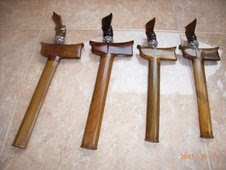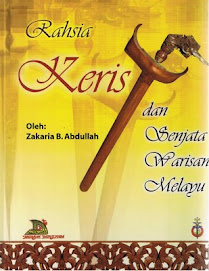THE DEVELOPMENT OF SILAT SENI GAYONG
Silat Seni Gayong was formulated and founded by Mahaguru Dato' Meor Abdul Rahman bin Uda Mohd.Hashim. He was of bugis decent born in 1915 and was the great-grandson of Daeng Kuning, commonly known as Panglima Hitam.
Meor Abdul Rahman began learning the knowledge of silat at the age of twelve from his grandfather Tuan Syed Zainal Syed Idris Al-Attas. Syed Zainal is one of the warriors who fought against the British colonialism of the 19th century, in Pahang. Syed Zainal inherited his silat knowledge from Daeng Ambok Solok, a bugis warrior residing in Jambi Sumatra at that time.
For three years, Meor Abdul Rahman trained and learned with other students of Syed Zanial.
At 19, Meor Abdul Rahman successfully achieved the understanding and the 'selok-belok' (the ins and outs), the art of seni gayong. However, his grandfather did not perform the "ritual of authorisation" of silat gayong on him, as he had foreseen in a prophecy that Meor Abdul Rahman will have this ritual performed on him by a greater (unseen) warrior.
In 1936, the "ritual of authorisation" was performed on Mahaguru Meor Abdul Rahman by none other than the legendary Hang Tuah. Needless to say, this was an incident on the meta-physical (spiritual) level. Some stories report that the whole ceremony took place in a kind of "dream". This incident occurred on a large black rock by the river at Hutan Menam (now Southern Thailand). All the secrets and knowledge of Silat were transmitted to him and he was given the trust to teach and spread Silat Seni Gayong to the best of his ability.
Meor Abdul Rahman was given the title Panglima Sendo (invincible warrior), by his Royal Highness Sultan Alang Iskandar, after demonstrating his skills and ability to the royal court and dignitaries. The Sultan was so impressed and pleased by Meor Abdul Rahman that he took him as his adopted son. Meor Abdul Rahman stayed at the palace until the Sultan's death in 1938
In 1938, Meor Abdul Rahman moved to Singapore looking for work. There he found work at the British Royal Signal Corp Barrack, Killman, Woodland. From there he later became the un-armed combat instructor to the British soldiers. When the Japanese army attacked Singapore in 1942, Meor Abdul Rahman escaped with his family to Pulau Sudong (island south of Singapore).
He underwent much hardship and trials before finally being allowed to reside there. Being a "lawless" island, Silat Seni Gayong was much needed for the protection of one self and the community; therefore the art was re-introduced to the community.When Meor Abdul Rahman successfully saved the population of Pulau Sudong from the "Japanese threat", Silat Gayong was 'accepted' by the population, and taught throughout the island. Meor Abdul Rahman and his family then returned to Taiping, Perak.
In 1943 Meor Abdul Rahman was captured and imprisoned by the occupying Japanese Army. He was charged with treason against the Imperial Army and was sentenced to death by hanging. (This followed an incident in which Mahaguru 'fought off' a Japanese officer who had made rude advances towards his wife.) On the day of the execution Meor Abdul Rahman, bravely and against the odds, 'overpowered' his armed captors. For fear of further losses, the Japanese authorities released him. Soon after however, the Japanese managed to 'force' him to become one of their own soldiers.
When the Japanese surrendered in 1945, Meor Abdul Rahman and his family migrated yet again to Pulau Sudong. He was offered to become the 'Headman' of the island. During these years, Silat Seni Gayong spread to the neighbouring islands including those in Indonesian territories.
The year 1947 saw the appointment of Meor Abdul Rahman as an investigator with the Crime Investigation Department in Singapore. In this year too, he was awarded the 'King George VI' medal, an honour from the British Government, for his service in fighting the Japanese occupation of Singapore. In 1948 he actively spread Silat gayong throughout Singapore and on to the Malay Peninsula. After retiring from the police force, Meor Abdul Rahman established the first Silat Gayong Training School, at Lorong Fatimah, Woodland, Singapore. It was here that the early teachers or gurulatih of Gayong underwent their training.
In 1959, Meor Abdul Rahman met Dato' Onn bin Ja'afar, the founder of UMNO (United Malay National Organization), who offered himself to be a disciple of Silat Gayong. Dato' Onn suggested that Silat Gayong should be registered legally as an organization. Efforts began to register Silat Gayong and finally in 1963, this silat was officially registered as 'Pertubohan Silat Seni Gayong Malaya' with the registration number, 361.
PSSGM is the first silat ever to be registered in Malaya.After its registration, Silat Gayong continued to develop even more. From Singapore, Gayong spread to Johor. Meanwhile, in the north of the peninsula, Gayong spread on the effort of Meor Abdul Aziz, the elder brother of Meor Abdul Rahman and other 'gurulatih' sent from Singapore. Tengku Laksamana Kedah, on the royal command of Sultan Badlishah of Kedah had invited Silat Seni Gayong for a Command Performance in 1957.
The Silat Seni Gayong Training School was moved from Singapore to Kota Sarang Semut, Kedah, when the Mahaguru moved there in 1964.
In 1970, Silat Seni Gayong was invited by the Malaysian Government to be part of the National Entourage for The '70 Expo in Osaka, Japan. The Mahaguru and En. Razali Salleh (The Secretary General PSSGM then) accompanied two Gayong exponents, Che'gu Mustapha Kamal and Che'gu Mohd. Norsaii ,for the performances at the Expo, for two weeks. The Silat Demonstration was received with much encouraging enthusiasm and even 'surprised The Emperor Of Japan.The Silat demonstration was also widely publicised by the media networks in Japan.
Yet again, in 1971, The Silat Seni Gayong Training School moved to Air Kuning, Taiping Perak, when the Mahaguru moved there. Mahaguru Meor Abdul Rahman was then awarded the highest honour, The Dato' Paduka Cura Simanja Kini, by Sultan Idris Shah, the sultan of Perak. In this year as well, Silat Seni Gayong was introduced to the Malaysian Armed Forces. 87 personnel from the rank and file of the military underwent an intensive Silat Gayong training for six months at a military camp in Taiping. Upon completion, they were given authorization as teachers or Gurulatih of Silat Gayong and this Silat was taken to all the military camps in the country.
Silat Seni Gayong was then introduced to The Royal Malaysian Police in 1973. A similar intensive training course was held for 48 police personnel from the lower ranks. Similarly, upon graduating, they were ordered to spread Silat Seni Gayong to all the Police training schools in Malaysia.
Mahaguru Dato' Meor Abdul Rahman passed away and returned to Divine Presence on the 23rd of June 1991. According to the Will of The Mahaguru, after him, no one of his successors shall be titled 'Mahaguru'. Silat Seni Gayong would from then on be administered by a Board of Trustees, comprising of members who are trustworthy and strong on the 'cause' of Silat Seni Gayong. Before blowing his last breath, Dato' Mahaguru then appointed his daughter Che'gu Siti Kalsom as Trustee I, and Che'gu Mohd. Razali Salleh as Trustee II of Silat Seni Gayong Malaysia
Friday, May 25, 2007
Subscribe to:
Post Comments (Atom)



No comments:
Post a Comment